Innovative Advancements in Ultimate Frisbee Developed By Frank Huguenard
Has there ever been a single player who has brought as many innovations to the game?
In May of 2022, I drove up to Lexington KY to teach AJ Merriman, Johnny Bansfield and a group of players some basics of shredding. I wasn’t planning on playing (only coaching), I saw them not ‘getting it’ so I laced up my cleats, strolled on to the field, walked up to AJ and said “Daddy’s Home” and after not playing a single point of Ultimate in 5 years, I put up this no-look, left handed, backhand high release lift against the former AUDL Defensive Player of The Year. The distance between my release point and the DPOY’s nearest hand he could have blocked it with was approximately 6 feet.
This was not a set play, I pump faked righty flick, pump faked lefty backhand, started to fake a lefty backhand to Bansfield and out of the corner of my eye I saw my receiver cutting deep and as I’m pump faking another lefty backhand to my backfield, I was debating whether or not to throw for the score or shred…after all, I was there to teach shredding not humiliate AJ but after some internal debate, I let it rip……
By the end of the evening, both AJ and Johnny both independently said the same thing.
“in the future, there’s going to what are known as the ‘pre-Frank’ era and the ‘post-Frank era. Shredding completely revolutionizes the game”
AJ Merriman and Johnny Bansfield
This article is a brief summary and a partial list of some of the more prominent innovations that I’ve brought to the Ultimate Frisbee world over the past 45 years.
New Throw Development
Developed at least 22 new, unique and viable game ready throws for Ultimate. You can see the 1st 11 here (I developed another 11 in my sleep in November-December 2024):
Most notably, is the backhand reverse airbounce (what is now known as a backhand lift/backhand elevator, or somewhat incorrectly, the backhand high release), which I originally developed around 1981-82 (it took a few years to master).
I also coined the terms ‘lift’ and ‘elevator’ for the backhand lift by the late 1980s.
This scene below from Dogtown (especially at about the 1:00 minute mark) not only speaks to how the community in general reacted to my backhand lift, but to my entire platform of innovative advancements in the game “….that ain’t ultimate, what the hell is that?” and I’d be like “pfft, that ain’t ultimate, let me show you what Ultimate really is”. And here I am, 35 years later still trying to show you what Ultimate Frisbee really is…
It was because of watching this film (and specifically this very scene) that inspired me to name my original site Z-boyz.org in 2024 when I first started publishing most my ideas. Larry Bertlemann is an interesting cat in this story too, as he was the Godfather of Shredding on a surfboard who inspired the Zephyr Team to revolutionize skateboarding.
*Hex Formation Offense (1986)
On the way driving up to a Chico Pioneer Days tournament in Northern California 1986, I developed the original ‘hex’ formation offense and we instantly won that tournament, running that prototype offense for the first time.
The Hex formation was simply a framework to run a “thrower initiated” offense through (in other words, the hex was never intended to be an offensive system per se, only a framework for one).
That would be like calling a basketball offense The Pentagon Offense*, just because it’s shaped like a pentagon. (*that’s funny, I thought Shock and Awe was the Pentagon Offense).
These positions were commemorated in a 2004 web page I authored describing the motion offense that the ‘hex’ formation facilitated (red lines added to the original copy for effect):
*I just referred to the offense as a 2-3-2, but clearly from this diagram you can see the hexagonal polygon surrounding the center post.
Center Post Position
The straw that stirs the drink.
The Center Post is the player that really facilitates this entire motion offense. As opposed to long, circular come back cuts (or ‘in cuts’), the Center Post in this offense makes what I would call shorter, ‘piston’ cuts. The Center Posts job is to anticipate and facilitate the entire thrower initiated offense.
If his defender gets in front of him, he simply manages to go back just far enough to lure the defender behind him again. I call it the position the ‘post’ in honor of the basketball where the center (typically the center) “posts up” against his defender to get the ball. Thus, the center post player is usually has a wide body, tall, physical, free safety kind of build that’s a lot of work to get around.
While in a thrower initiated offense, the thrower technically can initiate off of any of the six other players on the field, clearly the center post is the most beneficial in terms of leaving available the most number of options once the thrower gets the disc back in the center of the field. An effective center post/point guard dual (think John Stockton/Karl Malone) is essential for an effective motion offense to reliably and consistently establish flow from a standstill position.
Even if the disc doesn’t go through the Center Post, just the viable threat that constantly exists wreaks havoc on the defense and helps spread the defenders out.
Part of the reason this hexagonal formation works so well is the sheer number of constant attack vectors that are ever present, and the center post is possibly the second most important position in this offense (next to the thrower who is responsible for initiating the offense).
Power Position
Out of this thrower initiated formation, we ran plays that we called The Bermuda Triangle. The blue dashed line (below) is the throw, the gray line is the power cut and the yellow dashed line is the return throw from the center post (red square is the defender who got ‘lost in the Bermuda Triangle’).
This play set up hundreds and hundreds of uncontested hucks in the last 80s, early 90s. At some point, by the 2000s, I began to hear people refer to it as ‘the power position’ but I had been running this play consistently and effectively for fifteen years prior to that, based on the ‘hex’ formation. I was like “hey, that’s my offense”…..(although to be completely fair, to call it the power position completely misses the point and really belays the true shred potential of the move, but more on that later).
Power Move
The power move was developed in 1993 and was a huge part of our success that year. Considered by many in the community to be a ‘dangerous’ play (somewhat baselessly, I don’t recall anyone who was ever injured in this play).
The play starts off with the disc in the hands of the center post. One of the two guards (called flankers in this diagram) make basically an inverted come-back cut [Green in Diagram] directly at the center post (*I say inverted because come-back cuts typically are coming back away from the attacking endzone, but these go from the backfield towards the attacking endzone, directly at the thrower). The throw itself would only be a couple of feet (the short light purple line in the diagram) but the yardage gained (YAC) would be the full extent of the three steps required to come to a stop and plant a pivot foot [Yellow in Diagram]. Completely legal play.
Seth Blacher and Chris ‘Toaster’ Hayden used the Power Move extensively in Jam’s “Plink-O” offense, which as a copycat of my motion offense (except extremely illegal). Peter Rive of Jam, referred to me as the Godfather of Plink-O, so clearly he acknowledged my innovations in that regard.
Seth and Toaster even referred to that play as the power move and talked about how the yardage gained was much longer than the distance of the throw. This is part of the reason that many in the Bay Area referred to Plink-O as “Frank’s Offense”.
Fully Ambidextrous Team
A big part of this new offensive paradigm I developed around a thrower initiated offense was the idea that everyone on the team was required to be able to throw with both hands. That’s not to say that every player could or should be able to throw a full field, off handed flick, but in the simple case of the above power move (for example), it was critical that all the players would know how and when to be able to throw a 2-3 foot off handed backhand to a dribbler. This was happening circa 1986….
Dribbling
At least four major factors or realizations came out of this thrower initiated offense that I had begun developing in 1985-1986.
The best time to get open, against the best defenders in the game, was while you were throwing.
Because they are in the act of marking you, and trying to prevent you from throwing a completion, they have much less of an ability to limit your ability to be a receiver.
A thrower initiated offense means that there is significantly (to possibly an order of magnitude) less running by the other six players.
This equates to extraordinarily high efficiency, less fatigue, less injuries, etc.
Much less fouling on the reception in a thrower initiated offense.
Because of the quick pace, shorter throws and deceptive movements, defenders had much less of an opportunity to ‘tee up’ a possible receiver for a hard foul (The Uglimate era of the late 80s brought with it a lot of intense fouling).
The more pressure a thrower initiated offense put on the defense, the softer the defense was forced to play, and the softer the defense played, the easier it became to run a thrower initiated offense.
As a result of the successes he had and all of these revelations (and more), by 1989 I started a new team based on these concepts and a full blown offensive system based on dribbling was born.
Rocker Back Position
One of the most important elements in my motion offense is the concept (again from basketball) of playing “off the ball”, or “cutting without the ball”. When I’m playing Rocker Back, a good 15%-25% of my Shredding is done without the disc.
The Rocker Back is a secondary guard (sort of like a shooting guard) position where you traverse the field as your team approaches the goal line but you are cutting in large arches, east to west and back again, behind the play (for the most part) always providing backfield support behind the primary guard.
The easiest time to get open is when you are throwing the disc, so obviously, with an accomplished Shredder, what you want to do is to do anything and everything you can to make sure they don’t get the disc.
The Rocker Back is my solution to this problem. I love playing Rocker Back….because sooner or later, no matter how hard you try, and no matter even if I’m a 64 year old out of shape player, I will get the disc, and when I do, you can’t stop me. Playing ‘off the ball’, so to speak, always gets me into position, eventually, to get an easy reception.
Once I have the disc in my hand, look out…..
Match Up Zone Defense
In the late 80s, the realization dawned on me that given all of the above consequences that poured out of running this new paradigm of thinking on offense, that man on man defense was simply way too easy to defeat. Ultimate has always been known to have an extreme bias in favor of the offense and this system I was developing inadvertently was exploiting this imbalance (I say inadvertent because I wasn’t intentionally exploiting the rulebook as much as I was just growing on what I had established as being very effective).
I like to say that the last time I played man on man defense was in 1988. By 1989, we were playing a match-up zone full time (or conventional zones). Of course we were mocked for it, until a few years later when Death or Glory began winning championships with their ‘Clam’ defense but as far as I know, we were the first time that deployed a full time match-up zone in the game.
Triple Threat Principle in Ultimate
In the early 90s, as our team was rapidly seeing our offense evolve and become a more graceful, powerful and unstoppable motion based offense, we gravitated away from a Football centric paradigm to more of a basketball centric paradigm. I drifted further and further away from playing quarterback and embraced becoming a point guard and began to study different basketball philosophies. I even had the opportunity once to ask Don Nelson how he coaches his motion offense and he gave me some interesting pointers (he emphasized a shift towards giving the players a lightweight framework to operate in and then trusting them to perform within it).
Dr. Jack Ramsey on the motion offense (from his book, The Coach’s Art) :
"What is this game that runs through my mind?
It is a Ballet, a graceful sweep and flow of patterned movement, counterpointed by daring and imaginative flights of solitary brilliance. It is a dance which begins with opposition contesting every move. But in the exhilaration of a great performance, the opposition vanishes. The dancer does as he pleases. The game is unified action up and down the field. It is quickness, it is strength, it is skill it is stamina, it is seven men playing as one. It is the solidarity of a single unifying purpose, the will to overcome adversity, the determination never to give in. It is winning; it is winning; it is winning."
When I first read that passage in 1993, it perfectly described the exact motion offense I was developing in Ultimate.
It is the most beautiful form of self expression that I know where the dance, the dancer and dancing all simultaneously merge into one as the disc becomes my dance partner. It blends the artistry of balance, the grace and flow of ballet with the raw power, strength and will of athletic competition.
It stimulates the intellect, while inspiring creativity and improvisation. It is pure joy, it is unstoppable and it is objectively and significantly more fun than any other form of ultimate frisbee. It empowers the individual player by placing the trust in them to unilaterally take tactical, strategic and philosophical decisions as long as those decisions within the [lightweight] framework that the motion offense provides.
Embedded within this framework is the principle of the triple threat position (TTP), borrowed from basketball and implicit in the TTP is a firm mastery of dribbling a frisbee on the ultimate field. I’ve written extensively about the Triple Threat Principle in Ultimate over the past 20 years, with my most latest article here.
The Triple Threat Principle has always been true, in every possession, in every basketball game, at every level since the sport began and it is also always true in Ultimate, on every single reception.
Because the offense is based on tried and true principles, it always works, no matter the opponent, defensive alignment or weather conditions but this statement is made contingent of course on the aptitude, execution and selflessness of the players involved.
Ironically, 20 years ago when I began evangelizing the Triple Threat Principle as a completely legitimate philosophical framework in Ultimate, I was viciously mocked that ‘it’s impossible to dribble’ in ultimate. Now that more and more dribbling has become an accepted superclass of tactics in the game, people still say that there’s no triple threat because a score is just a pass. Silly wabbit.
Both as a defender and as a marker, you know that there’s a big difference between how you guard someone you know is ‘huck first’ players vs a more generic role player who is more of a passer than a scorer. Of course these are two completely different threats that a defender, as well as the entire defense, has to be aware of and guard against. So the three threats in Ultimate that an Shred Master can wield are to dribble-drive penetrate, to pass and to score.
Inverted Pivots
Starting back in the proto-dribbling days of the mid-80s, it became totally obvious to me that the the conventional ultimate frisbee act of catching the disc and immediately pivoting blindly up the sideline was anathema to the kind of offense I wanted to run.
Going back to 1986 and even before that, we put an emphasis on pivot inversion and pivoting back towards known offensive players instead of pivoting blindly to where a player may or may not be. Here is a list of 12 benefits of inverted pivots.
Deceleration Into Catches
Ideally, I think everyone would agree that it’s best to be able to decelerate into a catch rather than run through the catch at full speed.
When I say ideally, what I mean is that in the ideal situation, you are able to do this in such a manner as to not risk the throw being blocked or intercepted. Once you realize the amount of leverage all of these principles that I teach gives you, you begin to understand that it’s not only possible to decelerate into catches, it’s programable. You can orient your entire game around this one principle.
Deceleration is a big part of the NBA this year, and it’s something that I’ve been emphasizing in Ultimate for the past 35 years.
Emphasis on Rim Catches
As opposed to the perfunctory pancake catch that most players are taught as a fundamental, I began emphasizing Rim Catches around the same time. Again, all things being equal, and within a framework for a high probability of completion, I would think that most players would agree that it’s preferable to play a style where rim catches are prioritized over all other catches. Why? For the simple reason that with a rim catch, you immediately are in position to throw 6-12 throws (depending on if you catch with one hand or both).
Hand Signal Sideline Initiators
From 1989-1977 we ran a system where we overloaded the strong side of the field near where the disc was brough into play with one player 4-5 yards from the thrower and another player another 4-5 yards beyond that. Depending on how the defense set up against these two players, I would call a hand signal and basically immediately throw the disc as soon as it was tapped in.
The completion percentage on these plays was well over 98% with an average Time of Possession (ATP) of less than .500 seconds, resulting in a PER (Play Efficiency Rating) hovering around an astonishing 2.00 (I never understood why nobody every copied this system because it was so effective).
What all these plays did was to establish instant motion (1st Law of The Motion Offense; a disc in motion tends to stay in motion; a disc at rest, tends to stay at rest) and on the rare occasion where we couldn’t get the throw off for the given hand signal, we’d still have virtually the entire 10 second stall count to be able to run a play (but that was rarely needed).
For example, if both defenders lined up on the weak side, to prevent either player from executing a break mark cut/reception, I might call a play (with a hand signal) where they both dispersed in opposite directions, only to throw a cross field, stalling airbounce out to the ‘flat’ for a wide open reception:
On average, I probably got the throw off in 100-200 ms with an astonishing 98% completion percentage. In some tournaments, the PER on these plays would have approached an absurd 4 or 5.
Even more astonishing, having run these hand signal plays successfully hundreds of times over an eight year period (1989-1997), no other team ever tried to emulate them.
Most Contiguous Throws in a Game
Not sure this qualifies as an innovation, per se, but in a game in Santa Barbara in 1994 or 1995, against a team called Tampico, my team Monkeyshine threw an astonishing 167 completions in a row in a single possession for a score. I’m just assuming this is a record, as it’s such a massive number. We had a couple of other long strings this same game (155 and 142 respectively). They were playing a standard zone and we were just throwing lift after lift and at some point, we just started keeping track of the number of throws we put up in a point.
Frankly, if you included the point prior and the possession immediately after this sequence, we may have hit well over 200 consecutive completions.
Various Compound Tactics
Along the way, as the motion offense I was working on evolved, a wide variety of complex, compound tactic arouse. A compound tactic is a set of tactics deployed by two or more players to achieve a certain goal and maybe the most relatable or familiar compound tactic that most players can readily identify would be a dump-swing (consisting of three players, multiple cuts and two different throws but encapsulated within a single container). By definition, any play involving a dribble is a complex play and when you begin to see some regularity and success with a given pattern, you tend to repeat it. Some of these are:
Play Action Plays
Pick and Roll Plays
Up and under moves
Killer Crossover Dribbles
Stunt Moves
Drop Step Moves
Swing Moves
*Power Moves
*Bermuda Triangle (Power Position)
All of the hand signal plays mentioned
Funnel Plays
Split Action Plays
Layered vortices
etc.
*mentioned above
Shredding
By 2004, having been dribbling for the previous 15+ years and continually refining, advancing and honing my skills, what Ultimate Frisbee had become to me was closer to Skateboarding and Snowboarding than it was to Basketball.
The creativity, versatility and finesse you can incorporate into throwing a disc began to dwarf what you could do on a basketball court with a bouncy rubber ball. The Ultimate field began to become my own personal skatepark or snowpark.
While this may not make sense or resonate with a lot of people, it absolutely makes complete sense to me. My teammates were the ramps, rails and slopes and the defenders were the moguls and other obstacles I had to navigate through.
Except, unlike a skatepark or snowpark, my Frisbeepark™ is alive!!! It is a dynamic, constantly reacting, organically reorganizing and morphing into a new Frisbeepark™ with my every move and when I’m on my game, I’m in complete control over the entire scenery. It’s a beautiful thing to watch and pure joy to play.
To me, this is what Shredding is in Ultimate. It’s complete mastery of the disc, the elements, the defense and the flow. Shredding is liberation.
Within Shredding, as in skateboarding, there are dozens and dozens of nuanced elemental tactics that I’ve developed over the past 40 years, most of which no other players are even aware of.
It’s a lot of fun and it completely destroys everything you hold to be true about the game.
Sorry?
Advanced Drills
I’ve developed 15-20 drills to support the development of skills, mindset and acumen to be able to thrive in my motion offense. I would put any of these drills up against any other drill that’s ever been run. My drills all emphasize proper throwing mechanics, balance, quickness, dexterity, ambidexterity, leverage and efficiency.
Triangle Weave Drill
Dribble Chain
Gauntlet
Ballbreaker
Ring Drill (Drop-In Swimming Pool Drill)
Triangle Drill
Dropstep Swim move Drill
Backhand Dribble Drill
Flick Dribble Drill
Most Footblocks Ever
Hard to call this an innovative advancement but maybe it was. Who knows? But in my body of work, it deserves an honorable mention at least.
My first tournament at Purdue I had 15-20 footblocks.
In a single tournament.
At the risk of sounding like Wilt Chamberlain, I’m certain I have over 10,000 footblocks over the past 45 years, at all levels.
**Most Handblocks Ever Too *(at least 5,000)
Advanced Statistics
Most of the statistics in Ultimate are a meaningless joke and are basically useless in terms of helping a coach make better game time decisions, etc.
Over the years, I’ve developed an array of state of the art statistics for monitoring, evaluating and analyzing critical game performance.
Forced throw-aways (incompletion percentage for all throws you’re marker of)
Player Efficiency Rating (or Play efficiency Rating, Team Efficiency Rating)
Average Time of Possession (ATP)
TCP (Total Completion Percentage)
ATA (Average Time to Attack) *[to Triple Threat Position]
TIP (Thrower Integrity Percentage)
True Assists (as in Basketball, the assist goes to the player who passed to the player who then shoots for the score) are worth two points, a Goal is one point (catching in the endzone) and a Score (throwing a Goal) is one point.
*please don’t call it a ‘hockey assist’; call it an Ultimate Assist.
Shock-Corded, Brushed Aluminum Goaltimate Goals
Skyd Magazine actually did a full article on my kits, but they neglected to give me credit, in spite of repeated requests (you can see in the comments below their article where I have a photo from 2005 with Ben Wiggins in Santa Cruz)
Spring loaded, Artificial Turf Goaltimate Hoop Holders
These are 80 pound steel plates, covered with artificial turf and with springs welded on to them. Ideal for playing Goaltimate or Dischoops on astroturf or indoors.
Spring Loaded, Natural Turf Goaltimate Hoop Holders
For the sake of completeness, I’ve included photos of these spring loaded rebar hoop holders. These provide much better flexibility and strength to the arches to be able to withstand collisions and discs crashing into them (which has been known to bust up PVC pipe kits).
Dischoops
Last, but not least, my greatest innovation ever….






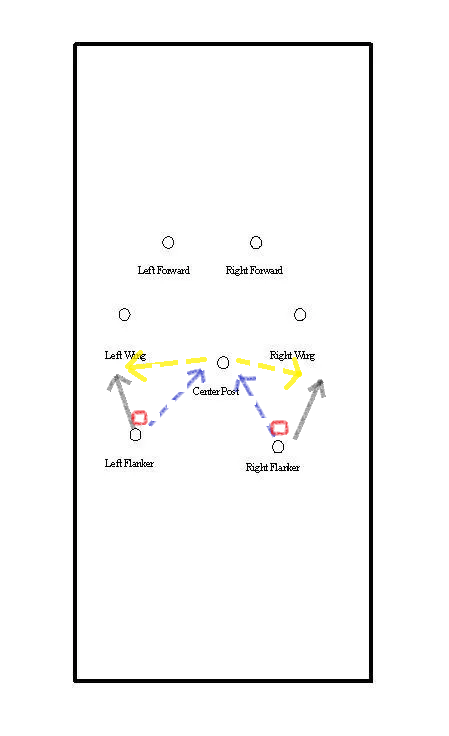



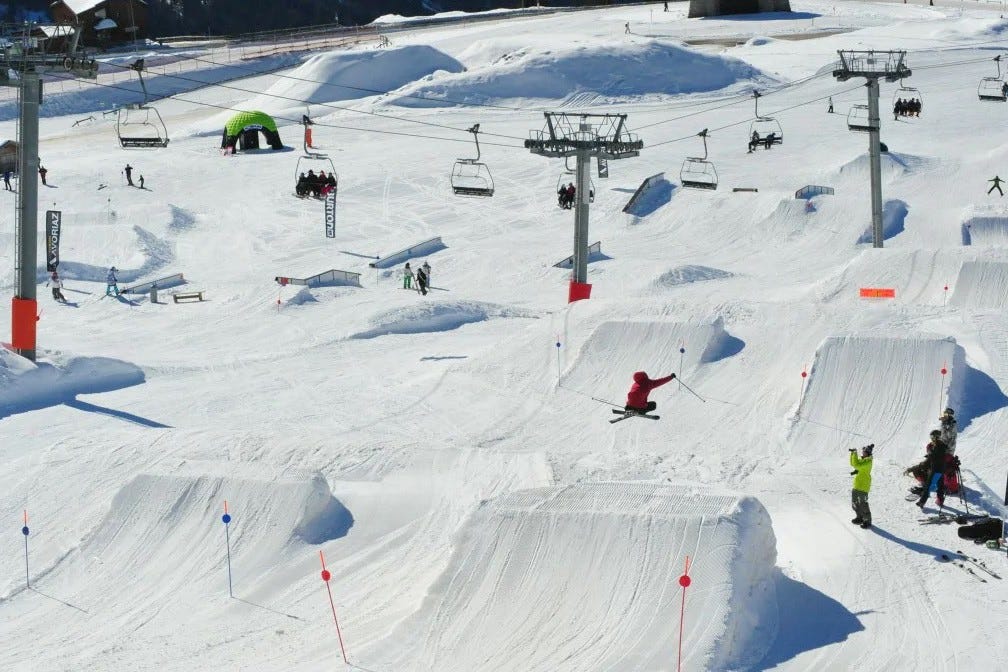

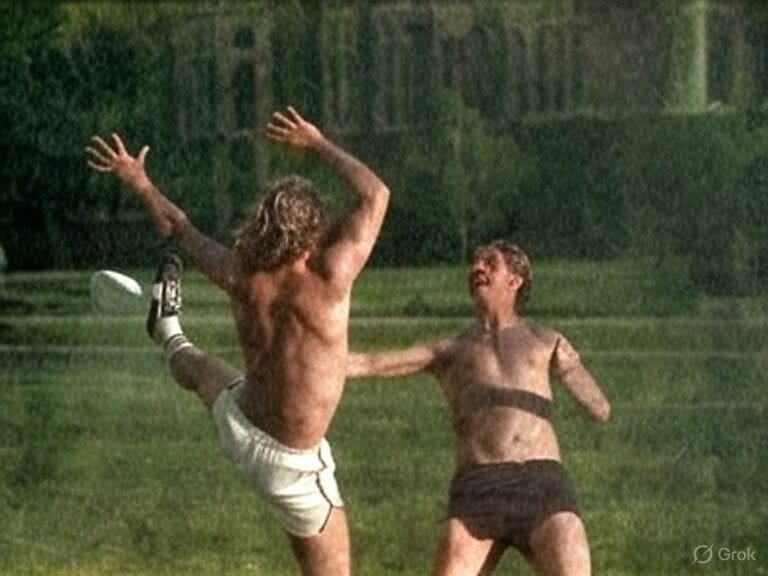
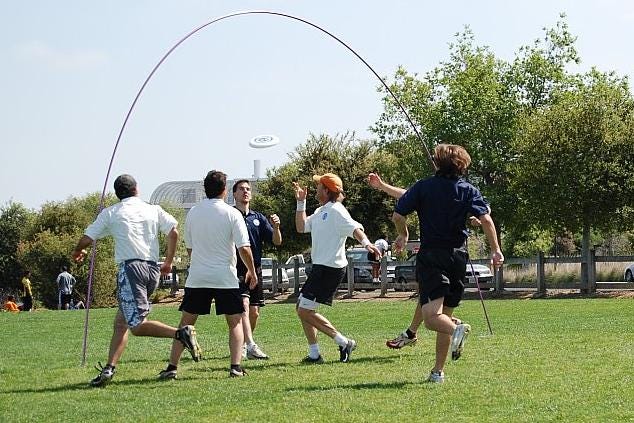
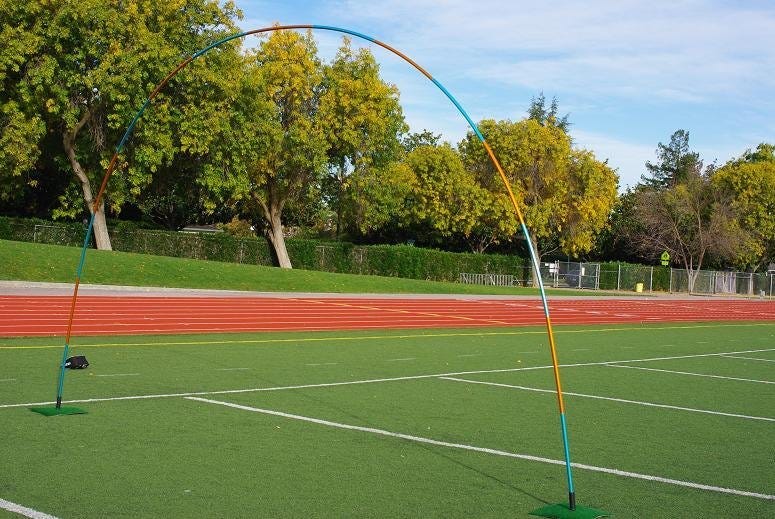

Lots of good food for thought. I'd be really interested in hearing or seeing (diagrams?) more about the rocker back position. Can you share more?